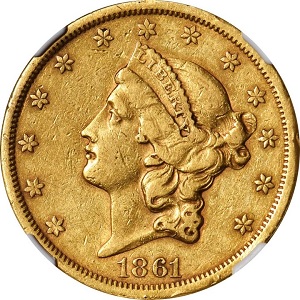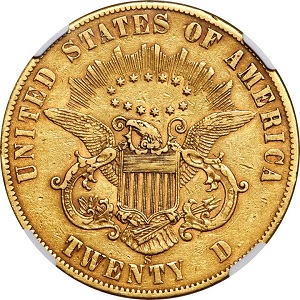1861-S Coronet $20 Double Eagle, Paquet Reverse
Anthony C. Paquet was born in Hamburg, Germany in 1814 and took up residency in Philadelphia in 1848. As an experienced engraver, he worked for the United States Mint from 1857-1864.(1)
In 1860, Assistant Mint Engraver Paquet modified the reverse design of the Coronet $20 double eagle by making the lettering taller and thinner, while narrowing the rim.
In advance of 1861 coining operations, the dies for Paquet’s new reverse were made and shipped to the San Francisco Mint on November 7, 1860, and to the New Orleans Mint on December 10.(2)
The Philadelphia Mint began using the Paquet reverse very soon after New Year’s Day 1861, but quickly encountered manufacturing difficulties blamed on the new design. Mint Director James R. Snowden decided to scrap Paquet’s version and return to the old reverse.
Snowden sent telegraphs to New Orleans and San Francisco with orders not to use the new dies. New Orleans received the message in time to prevent striking of any Paquet reverse double eagles, but San Francisco did not. That’s because in 1861 there was no telegraph west of St, Joseph, Missouri. From that point, messages had to be carried overland.(3)
Snowden’s directive did not reach California until early February, but by then the San Francisco Mint had already struck and released 19,250 double eagles with the Paquet reverse. Apparently, the machinists at the western branch mint sufficiently overcame the production problems experienced in Philly.(4)
As was true for most coins from the early San Francisco Mint, the 1861-S Paquet double eagles travelled extensively in the regional economy for many years. The surviving population of approximately 267 examples is characterized by heavy wear and below average eye appeal.(5)
Fascinating Fact: Director Snowden ordered the Paquet coins in Philadelphia to be destroyed. All were, except for two examples. The 1861 Philadelphia Mint Paquet Reverse double eagle without question ranks among the greatest American numismatic rarities. One of the two, graded MS-67, sold in August 2021 for $7.2 million.(6)
The 1861-S Coronet double eagle Paquet Reverse has long warranted the attention of advanced gold collectors because of its rarity and interesting history. Since the early 2000’s, the coin has moved rapidly higher, but not without some volatility. Regardless, it will always be one of the most sought after dates of the popular Coronet double eagle series.
| Estimated survivors in all grades: 267 ?
The survivor estimate from PCGS represents an average of one or more experts' opinions as to how many examples survive of a particular coin in all grades. Survival estimates include coins that are raw, certified by PCGS, and certified by other grading services. Learn more at PCGS. |
| PCGS Rarity Scale: 6.5 ?
The 'PCGS CoinFacts Rarity Scale' assesses the relative rarity of all U.S. coins, based on estimated surviving examples. The scale runs from 1.0 to 10.0. The higher the number, the rarer the coin.
Learn more at PCGS. |
| Click HERE to check for availability on eBay** |
Preview of eBay selection (If no Paquet $20s today, try again later -- try the HERE link as well):
 |
 |
| Trendline Avg = 22.62 | BETTER |
Historic Value Trend Charts:
| Last updated 10-9-243 | Return to Key Date Coin List | |
| Compare to Common Date Coin of Same Type | ||
|
|
||
| Download Charts to Your Computer | ||
Sources
1. Stack's Bowers Galleries. 1861-S Liberty Head Double Eagle. Anthony C. Paquet Reverse. Apr 2022 Auction.
2. Heritage Auctions. 1861-S $20 Paquet. Jan 2023 Auction.
3. Garrett, Jeff and Guth, Ron. 100 Greatest U.S. Coins, 5th ed. Pelham, AL: Whitman Publishing, 2019.
4. Heritage Auctions. 1861-S $20 Paquet. Jan 2023 Auction.
5. PCGS. 1861-S $20 Paquet (Regular Strike).
6. Heritage Auctions. 1861 $20 Paquet MS67. Aug 2021 Auction.
**Many very fine coin dealers sell on eBay. At any point in time, there may be over one million search results for United States coins. This includes quite a few of the recommendations on our Key Date Coin List.
If you’re thinking about purchasing a rare coin, eBay is certainly worth a look. For your convenience, the links from this site to eBay are coded to bring up only coins certified by PCGS and NGC.
As is always, always the case, never buy a valuable coin from a seller whose trustworthiness cannot be verified. Learn more about this at our chapter Best Places to Buy Coins, which also has a section on doing business on eBay.
In the interest of full disclosure, Rare Coins 101 receives a small commission anytime someone connects to eBay from this site and purchases something.
Coin images by Stack's Bowers Galleries.


